Key takeaways:
- Animal protection societies are essential for rescuing and advocating for neglected animals while promoting responsible pet ownership through education.
- Volunteering at shelters provides personal fulfillment and fosters a compassionate culture towards animals while offering valuable skills.
- Challenges in volunteering include emotional exhaustion and logistical hurdles, yet the positive impact on both animals and the community is significant.
- Connections formed between volunteers and animals can inspire community support and awareness for animal welfare, contributing to long-term change.

Animal protection society overview
Animal protection societies play a vital role in advocating for the welfare of animals across communities. I vividly remember a day when an organization I volunteered with rescued a group of kittens abandoned in a cardboard box. The emotions that ran through me—anger for their plight mixed with hope for their future—are a testament to the urgent need for such entities. How could anyone overlook the innocent lives that rely on us for support?
These societies not only provide shelter but also actively work towards educating the public about responsible pet ownership. During my time there, I saw firsthand how workshops transformed people’s understanding of spaying and neutering. It struck me that these simple actions can significantly reduce the number of homeless pets—what if everyone took the time to learn about this?
Moreover, these organizations face numerous challenges, including funding and the continuous need for volunteers. I’ll never forget meeting a fellow volunteer who dedicated her weekends to caring for abandoned dogs; her passion was contagious. Isn’t it incredible how a single person’s dedication can inspire others to get involved, creating a ripple effect that helps countless animals?
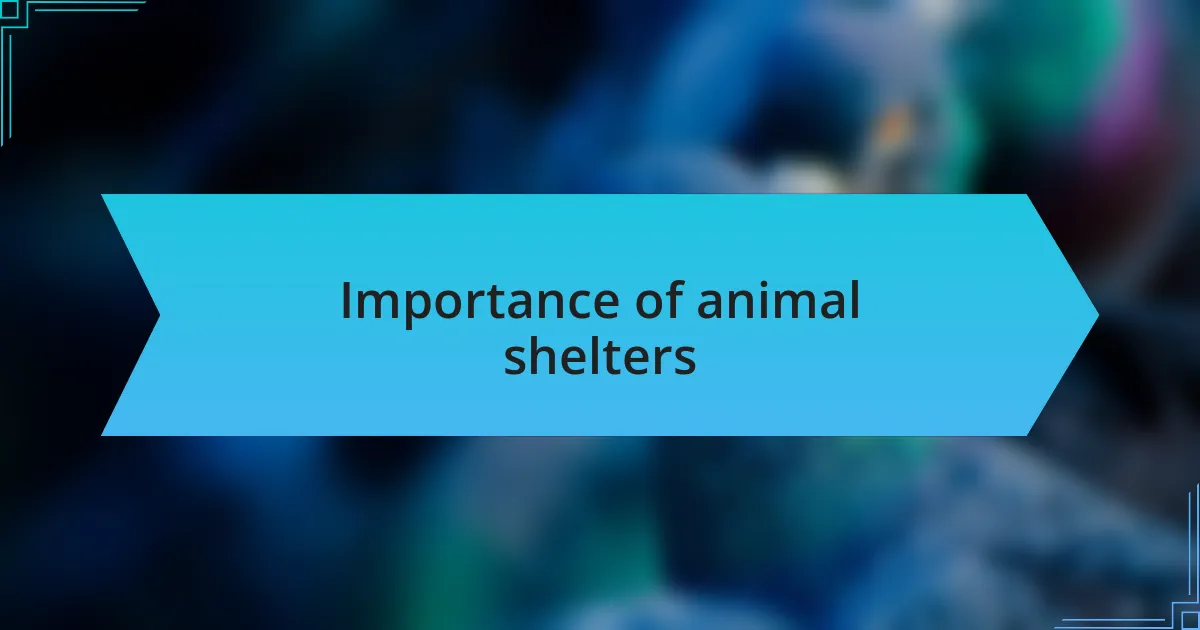
Importance of animal shelters
Animal shelters serve as a crucial lifeline for countless abandoned and neglected animals. I remember walking into a shelter for the first time and being overwhelmed by the sheer number of animals waiting for homes. Seeing their hopeful faces made me realize that these shelters are not merely places of refuge; they are sanctuaries where animals can find stability and care.
These facilities also tackle the larger issue of animal overpopulation through spaying and neutering programs. During my volunteer stint, I participated in a community outreach event that aimed to educate pet owners on these procedures. Witnessing pet owners share their stories and understanding the positive impact of responsible ownership filled me with hope; if shelters can educate and empower communities, we can make significant strides in reducing the number of homeless animals.
Moreover, shelters provide a unique opportunity for people to form connections with animals in need. I still recall the bond I formed with a gentle older dog named Max; he had been overlooked for months simply due to his age. This experience made me question—how many wonderful companions are waiting for someone to see their true worth? By adopting from shelters, we not only save lives but also enrich our own.
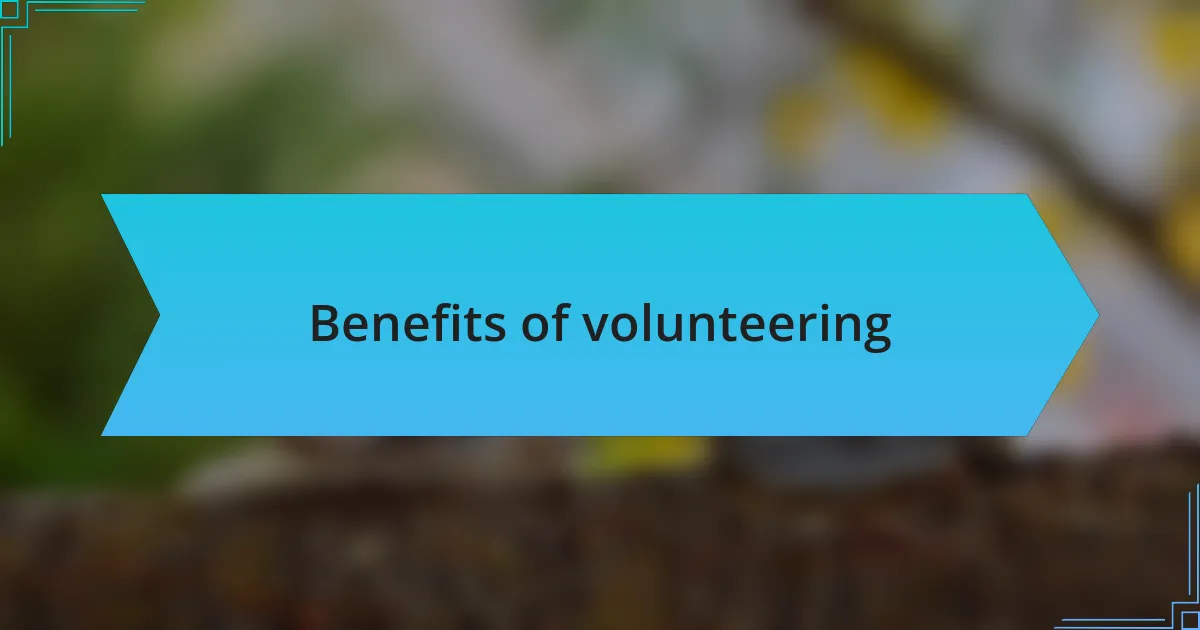
Benefits of volunteering
Volunteering at animal shelters offers a profound sense of purpose that enriches your life in unexpected ways. I vividly remember the first time I sat with a shy cat named Luna, who slowly approached me after a few tentative moments. The joy and connection that emerged in that quiet setting were deeply fulfilling; it reminded me how small acts can make a substantial impact on an animal’s well-being and my heart.
Beyond personal fulfillment, volunteering benefits the community by fostering a compassionate culture towards animals. I once participated in a shelter event where families could bring their children to meet the animals. Seeing the children’s eyes light up as they interacted with the pets was not only heartwarming but also inspiring. It made me realize that my involvement was helping shape future generations who would be more aware and responsible about animal welfare.
Additionally, you gain practical skills while volunteering that can carry into other areas of your life. I learned basic animal care techniques, effective communication skills, and even crisis management when dealing with frightened or aggressive animals. These experiences have not only enhanced my confidence but have also prepared me for various challenges outside the shelter. What better way to grow personally and professionally than through the bonds formed with those sweet souls waiting for their forever homes?
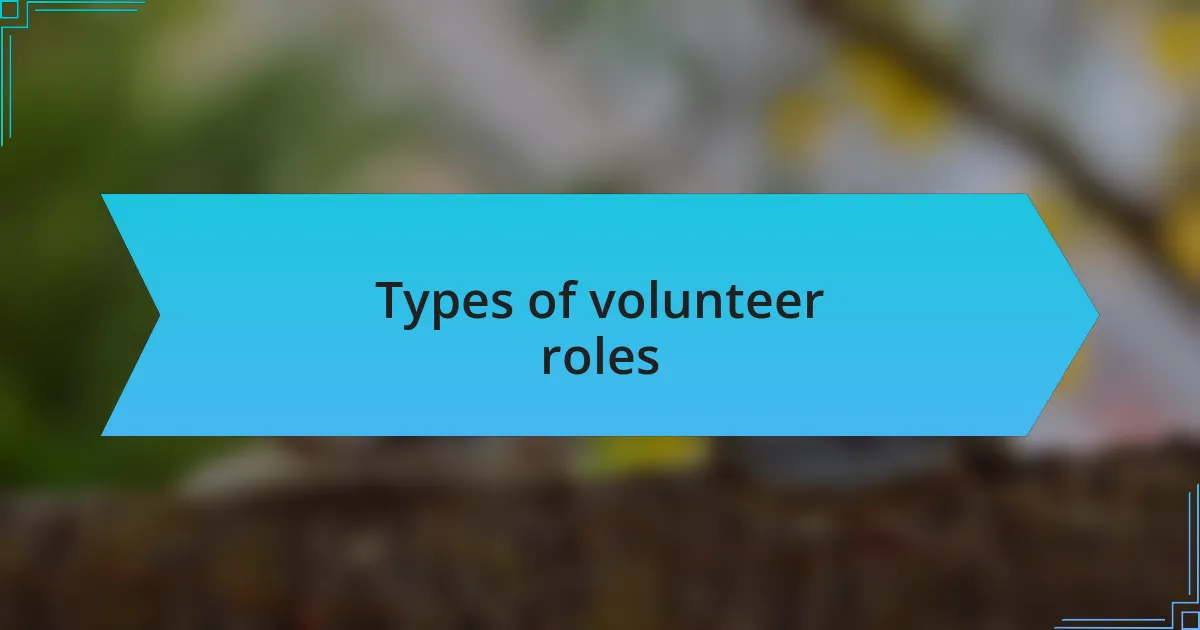
Types of volunteer roles
When I first volunteered at an animal shelter, I quickly discovered that there are various roles one can take on, each with its unique rewards. From helping with daily animal care, such as feeding and grooming, to administrative tasks like organizing donation drives, every role plays an essential part in keeping the shelter running smoothly. I found myself gravitating towards animal socialization, where I spent countless afternoons getting to know each animal’s personality and quirks.
Another engaging role is fostering animals, which really changed my perspective on the shelter experience. For a brief period, I welcomed a litter of puppies into my home, providing them with a safe space to grow and thrive. Watching them play and develop in a loving environment was incredibly fulfilling, not to mention the pride I felt when they found their forever families.
Then there’s outreach and education, an especially rewarding role where volunteers advocate for animal welfare in the community. I remember helping at a local school, where I shared stories about companion animals and the importance of adoption. Seeing children’s faces light up with excitement was a powerful reminder of why we do this work together—bringing awareness and compassion to future advocates for animal rights.
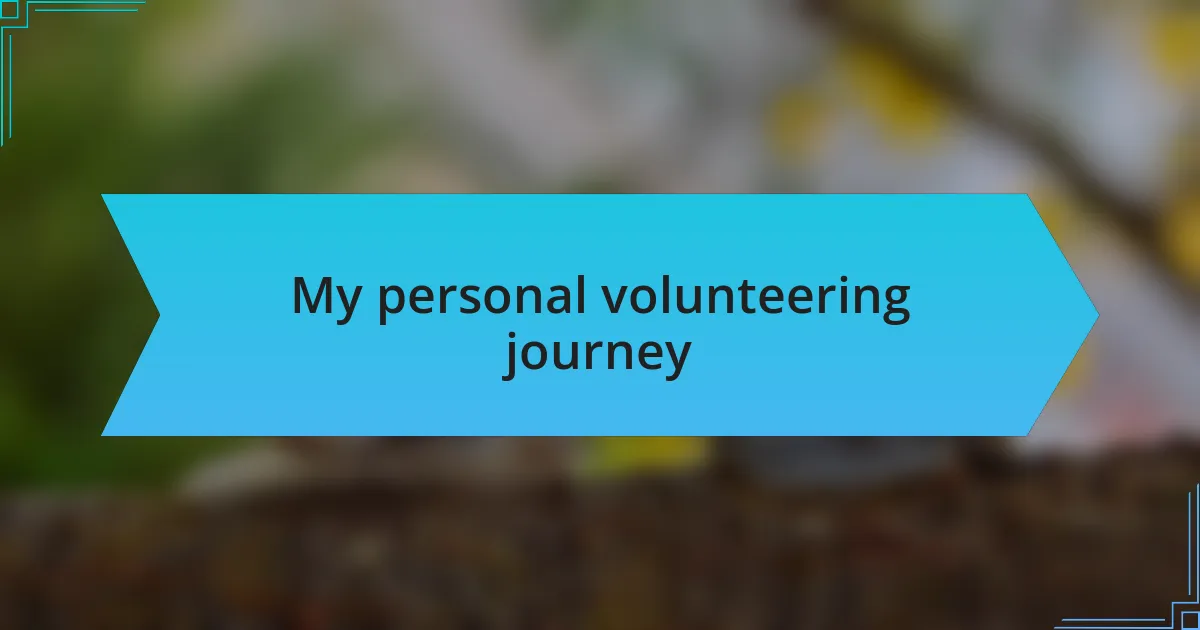
My personal volunteering journey
When I reflect on my personal volunteering journey, one moment stands out vividly. I remember the first time I entered the shelter, overwhelmed by the cacophony of barks and meows. But it was that very chaos that made me feel at home; these animals were just as eager for companionship as I was to give it. Have you ever experienced that instant connection with someone—or in this case, a furry friend? It’s a feeling that stays with you long after you’ve left.
As I settled into my role, I quickly learned the importance of patience and love. There was a timid dog named Bella who initially cowered in the corner, avoiding eye contact. It wasn’t until weeks later, after countless gentle interactions, that she finally approached me for a scratch behind the ears. That moment, when she wagged her tail and licked my hand, is etched in my memory. It was a testament to the healing power of kindness, reminding me how my presence could help build trust and transform lives.
One memorable Saturday, I decided to organize a small social event at the shelter. I reached out to friends, inviting them to meet the animals and learn about the adoption process. Watching their hesitation turn into excitement as they interacted with the pets was heartwarming. I realized that sharing these experiences didn’t just bring potential adopters to the shelter; it created a community around the mission of animal welfare. Have you ever witnessed the joy that comes from connecting people with animals? It’s utterly magical.
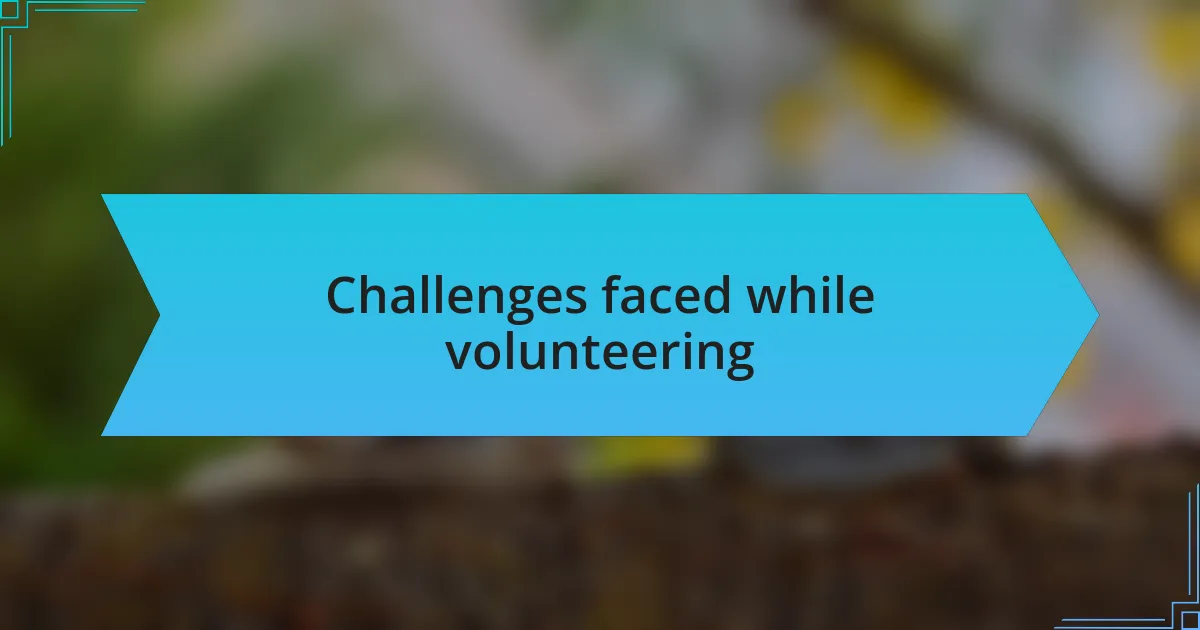
Challenges faced while volunteering
The challenges I faced while volunteering at the animal shelter were both eye-opening and humbling. I distinctly remember one particularly busy day when we received a sudden influx of animals. With each new arrival, I felt the weight of responsibility grow heavier. How could I give individual attention to every animal when there were so many? It reminded me that the demand for help is often greater than the resources available.
One hurdle that many volunteers encounter is emotional exhaustion. I often found myself wrestling with the stories behind the animals, each of them carrying their own burdens of abandonment and abuse. It was tough not to take these stories home with me. I learned that compassion can sometimes come at the cost of emotional fatigue, prompting me to find ways to recharge. Have you ever felt the need to step back and take a breather after being deeply affected by someone else’s pain?
Another challenge I faced was navigating the logistical side of volunteer work. From coordinating feeding schedules to managing supplies, the organizational aspects were sometimes overwhelming. There were days when the shelter felt more like a busy office than a haven for animals. Yet, I realized that tackling these tasks effectively was essential for ensuring the animals received the care they deserved. It made me appreciate the work behind the scenes even more, reminding me that every effort counts in making a difference.
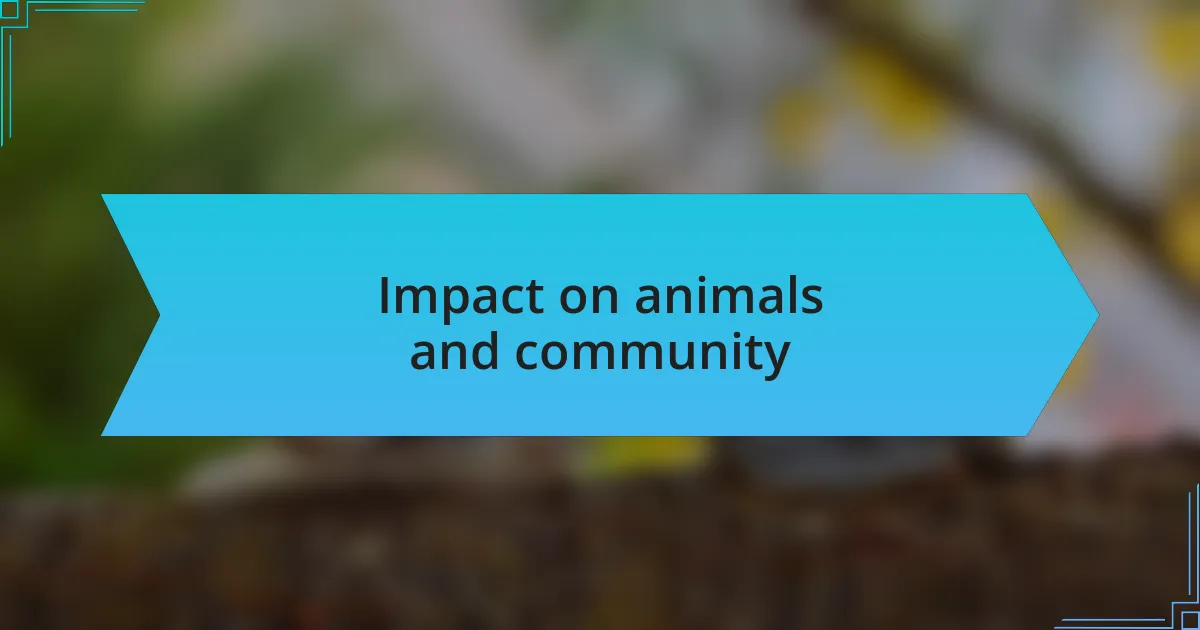
Impact on animals and community
The impact of volunteering at the animal shelter extends far beyond the walls of the facility. I vividly recall the heartwarming moment when a shy pit bull, previously too frightened to approach anyone, finally wagged her tail and nestled against me. That small act of trust not only demonstrated the power of love and patience for that animal but also showcased how compassion can ripple through the community, fostering a support system for vulnerable lives.
In my experience, the benefits of such interactions are twofold. Animals rescued from neglect and abuse found safety, while the community witnessed the transformation of these creatures and their new beginnings. I often saw families adopt pets who were once seen as unadoptable and share their inspiring stories at local events. How often do we forget that by saving one life, we can inspire countless others to act in kindness?
Moreover, volunteering has a profound effect on fostering empathy and responsibility within the community. Every conversation with fellow volunteers or the shelter staff reinforced the importance of advocating for animal rights. It became clear to me that having these discussions can spark awareness, encouraging people to reflect on how they can contribute positively. Did you know that just one act of kindness can influence someone’s perspective on animal protection for years to come?